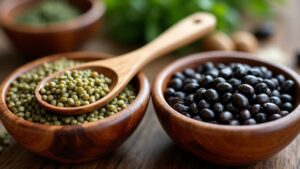Did you know lentils pack almost twice the iron of black beans per cup? In case you’re torn between these two legumes, it’s worth digging into their differences to see which fits your needs better. Both are protein-rich, fiber-loaded powerhouses, but they shine in different ways—from cooking time to nutrient density. Whether you’re meal prepping or just hunting for gut-friendly options, the choice isn’t as simple as grabbing whichever’s cheaper. So, which one wins for your plate?
Nutritional Comparison: Lentils Vs Black Beans
Upon comparing lentils and black beans, one will notice both pack a serious nutritional punch—but in slightly different ways.
Should you be looking for a protein boost, lentils edge out black beans with 17.9g per cooked cup versus 15.2g. Both shine in dietary fiber, nearly tied at 15.6g and 15.5g per cup, making them great for digestion and heart health.
Need more iron? Lentils deliver 7.39mg per cup, ideal in case you’re low on this mineral. But black beans win for potassium (1483mg per 100g) and folate (444µg per 100g), supporting muscle function and cell growth.
Whether you prioritize iron, folate, or protein, both fit a healthy diet—just pick based on your needs.
Health Benefits of Lentils and Black Beans
Should one be trying to decide between lentils and black beans, it’s not just about taste—both bring unique health perks to the table.
Lentils pack a punch with protein (18g per cup) and iron (7.4mg), perfect for muscle health and fighting fatigue. Their high dietary fiber (15.6g) helps lower cholesterol, reducing heart disease risk.
Black beans shine with folate (444µg), supporting brain function and cell growth, while their fiber (15g) keeps digestion smooth. Both are low-fat, aiding weight management.
Should you be plant-based, lentils’ iron is a standout, but black beans’ cardiometabolic benefits make them a heart-smart choice.
No wrong answer—just pick what fits your health goals!
Cooking and Preparation Differences
Should one be short on time but still want a nutritious meal, lentils could be your best friend—they cook up fast without soaking, while black beans need a bit more planning.
Lentils boil in 20-30 minutes, maintaining their shape for salads or soups, while black beans require soaking for 8+ hours to cut their 1-2 hour cooking time.
A pressure cooker speeds things up, slashing black beans’ prep to 30-40 minutes, but lentils still win with just 15-20 minutes.
Soaking both helps reduce anti-nutritional compounds, boosting digestibility and cutting gastrointestinal discomfort.
Black beans turn creamy, perfect for dips, while lentils stay firmer.
Should one be pressed for time or want easier digestion, lentils edge out black beans—just rinse and cook!
Dietary Considerations and Potential Drawbacks
While lentils save time in the kitchen, both they and black beans share some dietary quirks that could trip one up in case one isn’t prepared. Here’s what to watch for:
- Digestive discomfort: Black beans contain more hard-to-digest carbs, so soak them well to reduce bloating. Lentils are gentler but still high in fiber—pace yourself.
- Nutrient absorption: Phytates in both beans and lentils can block minerals like iron. Soaking or sprouting helps.
- Low-FODMAP diet: Lentils are often better tolerated when one is sensitive to FODMAPs.
- Cholesterol & blood sugar: Both stabilize levels, but overdoing fiber can backfire.
- Preparation methods: Cooking black beans thoroughly breaks down tough compounds, while lentils need less fuss.
Balance is key—know your body and prep wisely.
How to Incorporate Both Into Your Diet
Three simple ways to boost your meals with lentils and black beans include tossing them into soups, mixing them with grains, or blending them into hearty veggie patties.
For a protein-packed lunch, stir cooked lentils into quinoa or brown rice, pairing it with black beans for a complete protein. Their high fiber content supports digestive health, so add both to your weekly meal plan—try black beans in tacos or lentils in a cozy stew.
Since lentils cook faster, use them for quick dinners, while black beans, rich in potassium, shine in salads or dips. To maximize nutrient absorption, combine them with veggies or whole grains.
Their versatile cooking properties make it easy to enjoy their benefits without hassle.
Conclusion
So, lentils or black beans? One’s quick and packed with iron, the other’s a brain-boosting folate champ. One’s gentle on your gut, the other’s a heart hero. The real win? You don’t have to pick. Mix them into soups, salads, or stews—your body gets the best of both. Digestion happy, heart humming, muscles fueled. Why settle at the moment you can have the power of two?
*(Word count: 75)*


